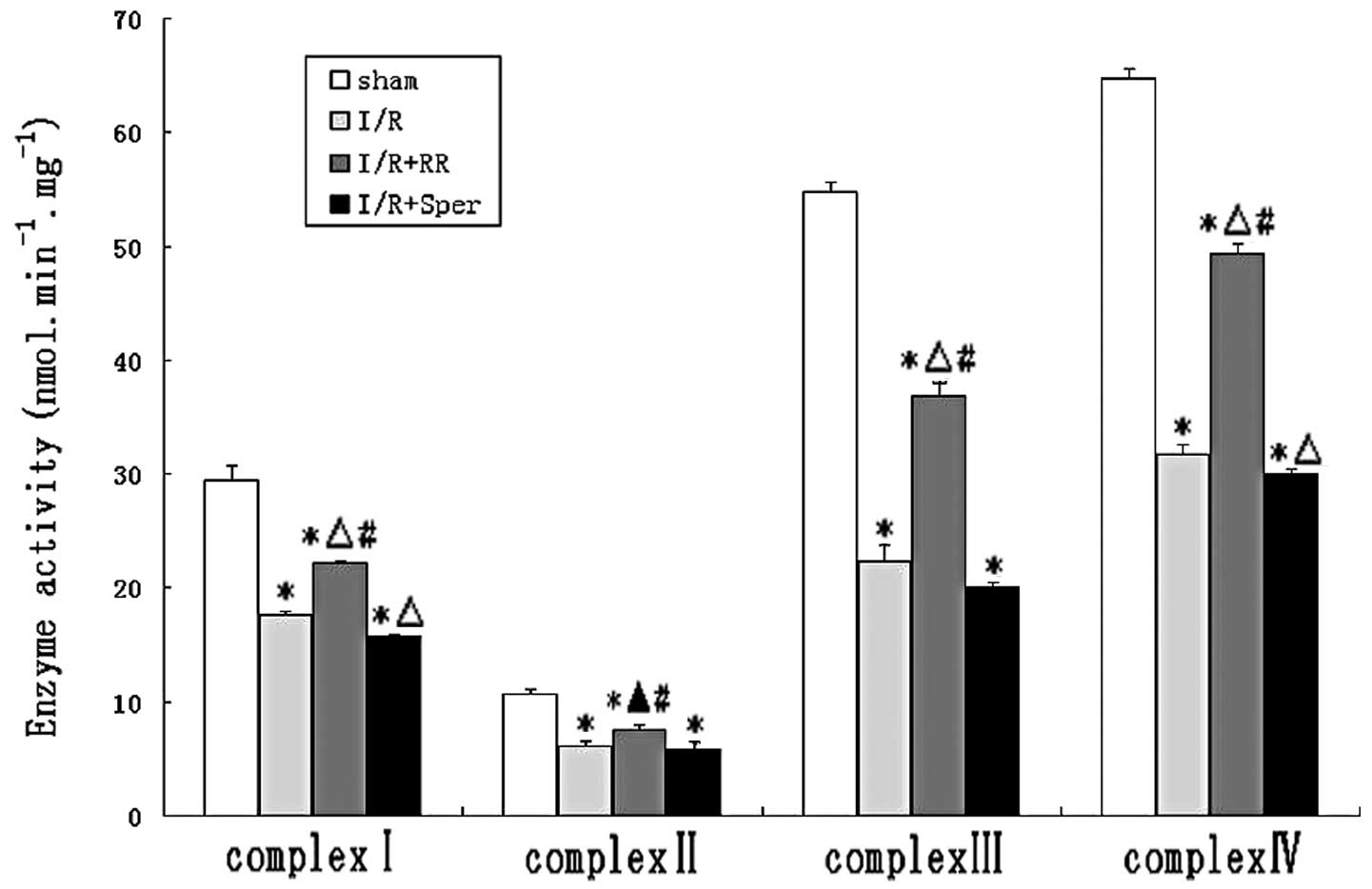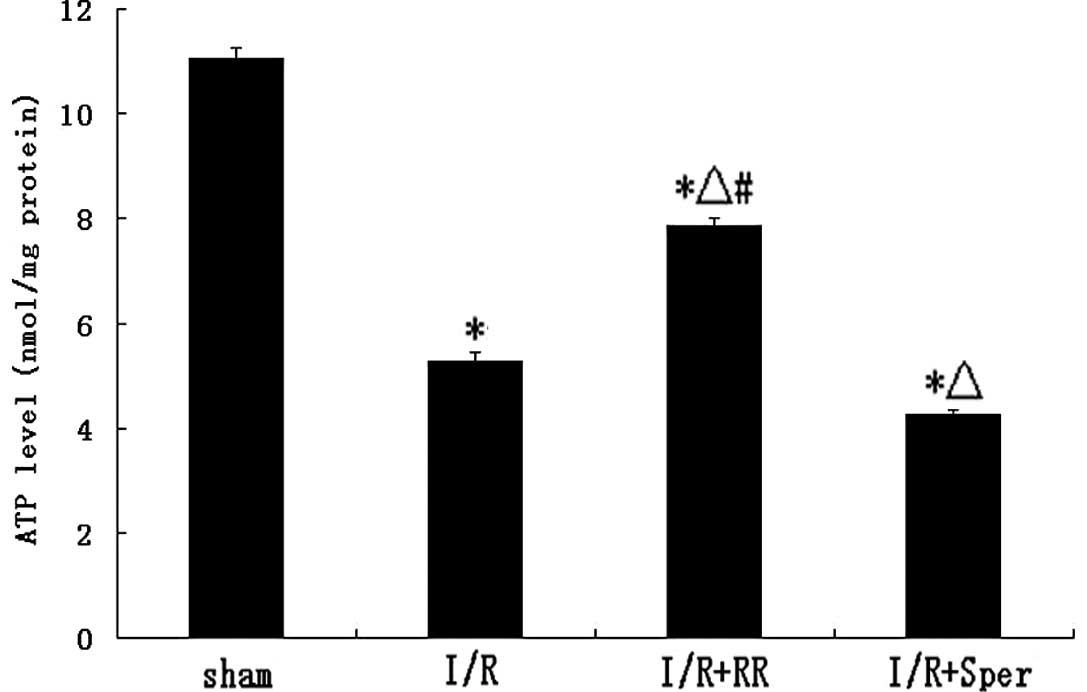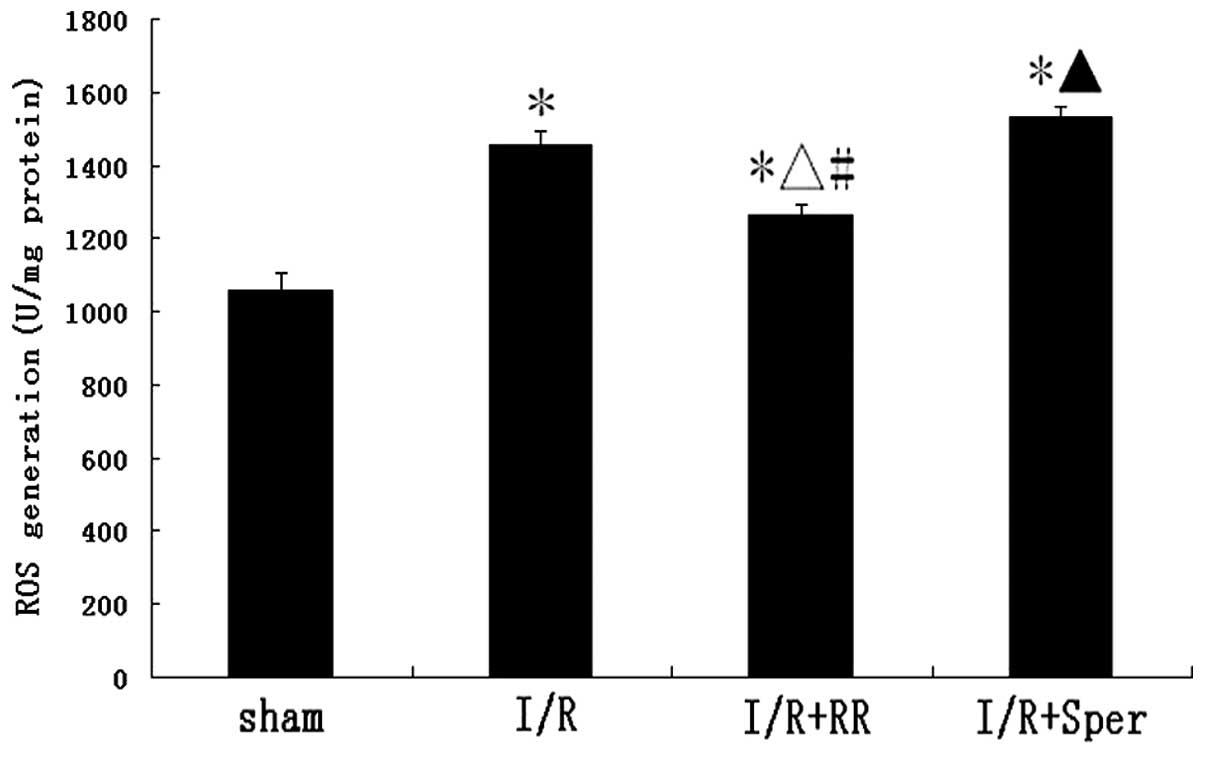|
1
|
Jennings RB, Sommers HM, Smyth GA, Flack
HA and Linn H: Myocardial necrosis induced by temporary occlusion
of a coronary artery in the dog. Arch Pathol. 70:68–78.
1960.PubMed/NCBI
|
|
2
|
Boyko M, Ohayon S, Goldsmith T, et al:
Cell-free DNA - a marker to predict ischemic brain damage in a rat
stroke experimental model. J Neurosurg Anesthesiol. 23:222–228.
2011. View Article : Google Scholar : PubMed/NCBI
|
|
3
|
Johnson DT, Harris RA, Blair PV and
Balaban RS: Functional consequences of mitochondrial proteome
heterogeneity. Am J Physiol Cell Physiol. 292:C698–C707. 2007.
View Article : Google Scholar : PubMed/NCBI
|
|
4
|
McBride HM, Neuspiel M and Wasiak S:
Mitochondria: more than just a powerhouse. Curr Biol. 16:R551–R560.
2006. View Article : Google Scholar : PubMed/NCBI
|
|
5
|
Sun Y, Deng T, Lu N, Yan M and Zheng X:
B-type natriuretic peptide protect cardiomyocytes at reperfusion
via mitochondrial calcium uniporter. Biomed Pharmacother.
64:170–176. 2010. View Article : Google Scholar : PubMed/NCBI
|
|
6
|
Sullivan PG, Rabchevsky AG, Waldmeier PC
and Springer JE: Mitochondrial permeability transition in CNS
trauma: cause or effect of neuronal cell death? J Neurosci Res.
79:231–239. 2005. View Article : Google Scholar : PubMed/NCBI
|
|
7
|
Demaurex N and Distelhorst C: Cell
biology. Apoptosis - the calcium connection. Science. 300:65–67.
2003. View Article : Google Scholar : PubMed/NCBI
|
|
8
|
Yan Y, Liu J, Wei C, et al: Bidirectional
regulation of Ca2+ sparks by mitochondria-derived
reactive oxygen species in cardiac myocytes. Cardiovasc Res.
77:432–441. 2008.
|
|
9
|
Young TA, Cunningham CC and Bailey SM:
Reactive oxygen species production by the mitochondrial respiratory
chain in isolated rat hepatocytes and liver mitochondria studies
using myxothiazol. Arch Biochem Biophys. 405:65–72. 2002.
View Article : Google Scholar
|
|
10
|
Chen Q, Moghaddas S, Hoppel CL and
Lesnefsky EJ: Ischemic defects in the electron transport chain
increase the production of reactive oxygen species from isolated
rat heart mitochondria. Am J Physiol Cell Physiol. 294:C460–C466.
2008. View Article : Google Scholar : PubMed/NCBI
|
|
11
|
Yu N, Wang S, Wang P, et al: The calcium
uniporter regulates the permeability transition pore in isolated
cortical mitochondria. Neural Regen Res. 72:109–113.
2012.PubMed/NCBI
|
|
12
|
Yang JP, Liu XF, Liu HJ, Xu GL and Ma YP:
Extracellular signal-regulated kinase involved in NGF/VEGF-induced
neuroprotective effect. Neurosci Lett. 434:212–217. 2008.
View Article : Google Scholar : PubMed/NCBI
|
|
13
|
Xu X, Chua KW, Chua CC, et al: Synergistic
protective effects of humanin and necrostatin-1 on hypoxia and
ischemia/reperfusion injury. Brain Res. 1355:189–194. 2010.
View Article : Google Scholar : PubMed/NCBI
|
|
14
|
Bradford MM: A rapid and sensitive method
for the quantitation of microgram quantities of protein utilizing
the principle of protein-dye binding. Anal Biochem. 72:248–254.
1976. View Article : Google Scholar : PubMed/NCBI
|
|
15
|
St John JB: Determination of ATP in
Chlorella with the luciferin-luciferase enzyme system. Anal
Biochem. 37:409–416. 1970.
|
|
16
|
Vander Heiden MG, Chandel NS, Williamson
EK, et al: Bcl-xL regulates the membrane potential and volume
homeostasis of mitochondria. Cell. 91:627–637. 1997.PubMed/NCBI
|
|
17
|
Emaus RK, Grunwald R and Lemasters JJ:
Rhodamine 123 as a probe of transmembrane potential in isolated
rat-liver mitochondria: spectral and metabolic properties. Biochim
Biophys Acta. 850:436–448. 1986. View Article : Google Scholar : PubMed/NCBI
|
|
18
|
LeBel CP, Ischiropoulos H and Bondy SC:
Evaluation of the probe 2′,7′-dichlorofluorescin as an indicator of
reactive oxygen species formation and oxidative stress. Chem Res
Toxicol. 5:227–231. 1992.
|
|
19
|
Ferrari R, di Lisa F, Raddino R and
Visioli O: The effects of ruthenium red on mitochondrial function
during post-ischaemic reperfusion. J Mol Cell Cardiol. 14:737–740.
1982. View Article : Google Scholar : PubMed/NCBI
|
|
20
|
Miyamae M, Camacho SA, Weiner MVV and
Figueredo VM: Attenuation of postischaemic reperfusion injury is
related to prevention of [Ca2+]m overload in
rat hearts. Am J Physiol. 271:H2145–H2153. 1996.
|
|
21
|
Griffiths EJ: Mitochondrial calcium
transport in the heart: Physiological and pathological roles. J Mol
Cell Cardiol. 46:789–803. 2009. View Article : Google Scholar : PubMed/NCBI
|
|
22
|
de García-Rivas GJ, Carvajal K, Correa F
and Zazueta C: Ru360, a specific mitochondrial calcium uptake
inhibitor, improves cardiac post-ischaemic functional recovery in
rats in vivo. Br J Pharmacol. 149:829–837. 2006.PubMed/NCBI
|
|
23
|
Clements-Jewery H: Mitochondria, the
calcium uniporter and reperfusion-induced ventricular fibrillation.
Br J Pharmacol. 149:811–813. 2006. View Article : Google Scholar : PubMed/NCBI
|
|
24
|
Rashidian J, Iyirhiaro GO and Park DS:
Cell cycle machinery and stroke. Biochim Biophys Acta.
1772:484–493. 2007. View Article : Google Scholar : PubMed/NCBI
|
|
25
|
Almeida A, Allen KL, Bates TE and Clark
JB: Effect of reperfusion following cerebral ischaemia on the
activity of the mitochondrial respiratory chain in the gerbil
brain. J Neurochem. 65:1698–1703. 1995. View Article : Google Scholar
|
|
26
|
Bernardi P: Mitochondrial transport of
cations: channels, exchangers and permeability transition. Physiol
Rev. 79:1127–1155. 1999.PubMed/NCBI
|
|
27
|
Trenker M, Malli R, Fertschai I,
Levak-Frank S and Graier WF: Uncoupling proteins 2 and 3 are
fundamental for mitochondrial Ca2+ uniport. Nat Cell
Biol. 9:445–452. 2007. View
Article : Google Scholar : PubMed/NCBI
|
|
28
|
Perocchi F, Gohil VM, Girgis HS, et al:
MICU1 encodes a mitochondrial EF hand protein required for
Ca2+ uptake. Nature. 467:291–296. 2010. View Article : Google Scholar : PubMed/NCBI
|
|
29
|
De Stefani D, Raffaello A, Teardo E, Szabo
I and Rizzuto R: A forty-kilodalton protein of the inner membrane
is the mitochondrial calcium uniporter. Nature. 476:336–340.
2011.PubMed/NCBI
|
|
30
|
Baughman JM, Perocchi F, Girgis HS, et al:
Integrative genomics identifies MCU as an essential component of
the mitochondrial calcium uniporter. Nature. 476:341–345. 2011.
View Article : Google Scholar : PubMed/NCBI
|
|
31
|
Dash RK and Beard DA: Analysis of cardiac
mitochondrial Na+/Ca2+ exchanger kinetics
with a biophysical model of mitochondrial Ca2+ handling
suggests a 3:1 stoichiometry. J Physiol. 586:3267–3285.
2008.PubMed/NCBI
|
|
32
|
Jouaville LS, Pinton P, Bastianutto C,
Rutter GA and Rizzuto R: Regulation of mitochondrial ATP synthesis
by calcium: evidence for a long-term metabolic priming. Proc Natl
Acad Sci USA. 96:13807–13812. 1999. View Article : Google Scholar : PubMed/NCBI
|
|
33
|
Komary Z, Tretter L and Adam-Vizi V:
H2O2 generation is decrease by calcium in
isolated brain mitochondria. Biochim Biophys Acta. 1777:800–807.
2008.
|
|
34
|
Rizzuto R, Marchi S, Bonora M, et al:
Ca2+ transfer from the ER to mitochondria: when, how and
why. Biochim Biophys Acta. 1787:1342–1351. 2009.PubMed/NCBI
|
|
35
|
Krause SM, Jacobus WE and Becker LC:
Alterations in cardiac sarcoplasmic reticulum calcium transport in
the postischaemic ‘stunned’ myocardium. Circ Res. 65:526–530.
1989.
|
|
36
|
Basso E, Fante L, Fowlkes J, Petronilli V,
Forte MA and Bernardi P: Properties of the permeability transition
pore in mitochondria devoid of Cyclophilin D. J Biol Chem.
280:18558–18561. 2005. View Article : Google Scholar : PubMed/NCBI
|
|
37
|
Regula KM and Kirshenbaum LA: Apoptosis of
ventricular myocytes: a means to an end. J Mol Cell Cardiol.
38:3–13. 2005. View Article : Google Scholar : PubMed/NCBI
|
|
38
|
Starkov AA, Chinopoulos C and Fiskum G:
Mitochondrial calcium and oxidative stress as mediators of ischemic
brain injury. Cell Calcium. 36:257–264. 2004. View Article : Google Scholar : PubMed/NCBI
|
|
39
|
Halestrap A: Biochemistry: a pore way to
die. Nature. 434:578–579. 2005. View Article : Google Scholar : PubMed/NCBI
|
|
40
|
Hardy L, Clark JB, Usmar VM, DR and Stone
D: Reoxygenation-dependent decrease in mitochondrial NADH: CoQ
reductase (complex I) activity in the hypoxic/reoxygenated rat
heart. Biochem J. 274:133–137. 1991.PubMed/NCBI
|
|
41
|
Sousa SC, Maciel EN, Vercesi AE and
Castilho RF: Ca2+-induced oxidative stress in brain
mitochondria treated with the respiratory chain inhibitor rotenone.
FEBS Lett. 543:179–183. 2003.
|
|
42
|
Yadava N and Nicholls DG: Spare
respiratory capacity rather than oxidative stress regulates
glutamate excitotoxicity after partial respiratory inhibition of
mitochondrial complex I with rotenone. J Neurosci. 27:7310–7317.
2007. View Article : Google Scholar
|
|
43
|
Grijalba M, Vercesi A and Schreier S:
Ca2+-induced increased lipid packing and domain
formation in submitochondrial particles. A possible early step in
the mechanism of Ca2+-stimulation generation of reactive
oxygen species by the respiratory chain. Biochemistry.
38:13279–13287. 1999.
|
|
44
|
Gincel D, Zaid H and Shoshan-Barmatz V:
Calcium binding and translocation by the voltage-dependent anion
channel: a possible regulatory mechanism in mitochondrial function.
Biochem J. 358:147–155. 2001. View Article : Google Scholar : PubMed/NCBI
|
|
45
|
Wikström M and Saari H: A spectral shift
in cytochrome a induced by calcium ions. Biochim Biophys Acta.
408:170–179. 1975.PubMed/NCBI
|
|
46
|
Cleeter MW, Cooper JM, Darley-Usmar VM,
Moncada S and Schapira AH: Reversible inhibition of cytochrome c
oxidase, the terminal enzyme of the mitochondrial respiratory
chain, by nitric oxide. Implications for neurodegenerative
diseases. FEBS Lett. 345:50–54. 1994. View Article : Google Scholar
|
|
47
|
Votyakova TV and Reynolds IJ:
Ca2+-induced permeabilization promotes free radical
release from rat brain mitochondria with partially inhibited
complex I. J Neurochem. 93:526–537. 2005.
|
|
48
|
Vygodina TV, Dyuba AV and Konstantinov AA:
Effect of calcium ions on electron transfer between hemes a and
a(3) in cytochrome c oxidase. Biochemistry. 77:901–909.
2012.PubMed/NCBI
|
|
49
|
Tretter L, Biagioni Angeli E, Ardestani
MR, Goracci G and Adam-Vizi V: Reversible inhibition of hydrogen
peroxide elimination by calcium in brain mitochondria. J Neurosci
Res. 89:1965–1972. 2011. View Article : Google Scholar : PubMed/NCBI
|
|
50
|
Zorov DB, Juhaszova M and Sollott SJ:
Mitochondrial ROS-induced ROS release: an update and review.
Biochim Biophys Acta. 1757:509–517. 2006. View Article : Google Scholar : PubMed/NCBI
|
|
51
|
Ly JD, Grubb DR and Lawen A: The
mitochondrial membrane potential (ΔΨm) in apoptosis; an
update. Apoptosis. 8:115–128. 2003.
|
















